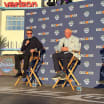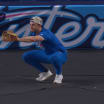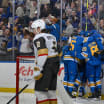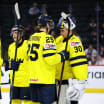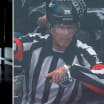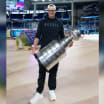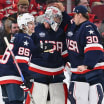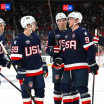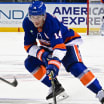Unmasked: Lundqvist was one of a kind, to have number retired by Rangers
Did things that 'won't be done again,' fellow goalies, former teammates say
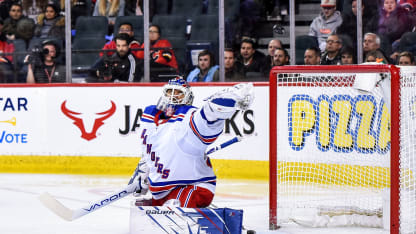
© Brett Holmes/Icon Sportswire
But will the NHL ever see a goalie like Lundqvist again?
He did things differently than his puck-stopping peers across the NHL, going 459-310-96 with a 2.43 goals-against average and .918 save percentage, even if it wasn't as obvious as the barrel rolls and contortionist tendencies of Hall of Fame goalie Dominik Hasek.
Ranked sixth all-time in the NHL in wins, and first in Rangers history, he will become the 11th player, and third goalie, to have his number retired by New York.
Steven Valiquette, a retired goalie who played with Lundqvist on the Rangers from 2006-10 and now works with him as a studio analyst on MSG Network, said he was one of a kind.
"I don't think we're ever going to see somebody that looks like him stylistically and plays like him technique-wise," Valiquette said. "We haven't seen it before or since, so what makes us believe we're going to see it again in the future?"
In many ways, each goalie is unique. There are limitless ways to combine the skills necessary to succeed in the NHL. At the same time, the position has trended toward the butterfly as a default description of goalie style rather than a save selection, and Lundqvist stood out, in part, because he didn't default to it throughout his career.
Lundqvist stayed well back in his crease so he didn't need to move as far to overcome lateral plays and relied on incredible patience on his skates to make saves without always dropping to both knees. It was the manifestation of the goal line-out tactical approach introduced to him upon his arrival in New York by Rangers goaltending coach Benoit Allaire.
"There's things that I believe won't be done again," said Minnesota Wild goalie Cam Talbot, a teammate of Lundqvist from 2013-15. "The biggest thing is the depth he felt comfortable at for his size [6-foot-1]. He was so quick laterally and his read of the release was so good he could play deep enough that it always allowed him at least a chance at making the second save. Most goalies his size continue to play somewhere around the top of crease if not farther out depending on the situation. I don't think 'Hank' ever stepped outside the top of his crease unless it was a breakaway."
Lundqvist's half-butterfly saves, with the glove-side leg pad staying up on saves to that side, have become a lost art. Robin Lehner of the Vegas Golden Knights and Jonathan Quick of the Los Angeles Kings are among the few remaining practitioners.
"He'd be on the goal line just reacting to shots from 20 feet that no one else had the courage to play from there," Valiquette said. "It takes a lot of courage to play deep."
By playing deep, Lundqvist always was in position to make a save, and therefore more open to criticism when he failed.
Goalies who play farther out often are given the benefit of the doubt when quick, lateral puck movement leaves them out of position. Lundqvist enjoyed no such luxury with his style.
"Every goal looked like it was on him because he always got there," Valiquette said. "He was never so far out of position that it looked like he never had a chance. That takes courage."
To drive those quick side-to-side movements, Lundqvist had his skates sharpened so that the inside edge of his blades was higher than his outside edge, making it easier for him to dig into the ice for a hard push or to hold those edges patiently in his upright stance.
"I'd never seen that; it was literally a razor blade," said retired goalie Martin Biron, who played with Lundqvist for parts of four seasons. "He was skating on razor blades."
It wasn't the only unique element of Lundqvist's equipment.
He once tried using a practice glove, which is beefed up with extra layers of padding for added protection but noticeably harder to close. He liked how big and open it presented to shooters so much that he adopted it as his game glove for years, despite the fact it was almost impossible to close. It gave rise to his signature glove save, his catching palm facing the sky -- like a waiter holding a tray -- because it was the easiest way to ensure the puck stayed in the too-firm pocket.
Perhaps Lundqvist's biggest contribution to goalie equipment came from wanting his leg pads to sit higher.
He stopped running the boot strap on the bottom of his leg pads, designed to anchor the pads, under his skates during the 2008-09 season. That strap hung loose behind his heel for three seasons until, with help from longtime New York Rangers equipment manager Acacio "Cass" Marques, he added a loop to the back of his skate for a game Oct. 11, 2011, which allowed him to tuck in the strap.
Then and there the "Lundqvist loop," was born. Today it is a staple of goalie vernacular and a fixture on goalie skates made by all manufacturers. It's a legacy, like his retired number, and a fitting way to remember a goalie whose combination of unique style and innovation may never be seen again.
"He didn't just play the position, he innovated it," said Kevin Weekes, who played two seasons with Lundqvist and now is an analyst for NHL Network and ESPN. "I don't think we'll see many like him that are able to impact the position in a unique way in terms of their style of play, their style of gear, the functionality of their gear, and the innovation that he brings to the table in all of those ways. It's so rare."
